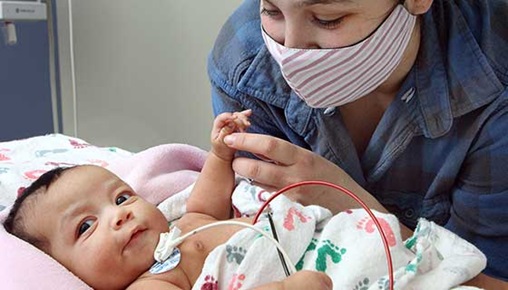Truncus Arteriosus (TA)
Truncus arteriosus, also known as TA, is a congenital (present at birth) heart defect. It occurs when there is one main blood vessel leaving the heart instead of two, which means that the oxygenated and deoxygenated blood is combined. Babies with TA need surgery to repair the defect. TA can be fatal if it is not treated.
TA is very rare. It affects about 1 out of every 10,000 live births in the U.S.
What is truncus arteriosus?
TA occurs when the two main blood vessels arising from the heart — the aorta and the pulmonary artery — do not separate as they should during fetal development. Babies with TA are born with one large vessel, or “trunk,” exiting the heart instead of two separate ones.
In most cases, TA occurs with another congenital heart defect called ventricular septal defect (VSD). VSD is a hole in the wall between the heart’s two lower chambers.
Other conditions that might occur with TA include:
- Aortic arch abnormalities, such as coarctation and interrupted aortic arch
- Patent ductus arteriosus
- Pulmonary stenosis
Truncus arteriosus types
There are four types of truncus arteriosus. All types include a single trunk vessel exiting the heart. The difference is how and where the right and left pulmonary arteries split off to bring blood to each lung. The type will affect how repair is done.
The four types are:
- Truncus arteriosus type 1: The most common form, occurring in about 60% of cases. The right and left pulmonary arteries branch off the main pulmonary artery once it separates from the common trunk.
- Truncus arteriosus type 2: The right and left pulmonary arteries branch off directly from the common trunk.
- Truncus arteriosus type 3: One pulmonary artery branches off the common trunk, and the other branches off the aorta.
- Truncus arteriosus type 4: Neither pulmonary artery branches off the main artery. Instead, they branch off the descending aorta (portion of the aorta that moves downward into the chest).
How does truncus arteriosus affect blood flow?
After babies are born and begin using their lungs, blood prefers to flow into the lungs rather than out to the body. TA causes too much blood to flow into a baby’s lungs, which makes the heart work harder to pump blood to the rest of the body. The blood that does get to the body does not have as much oxygen as it should because the circulation is mixed.
Truncus Arteriosus Symptoms
Truncus Arteriosus symptoms in infants may include:
- Breathing problems
- Cyanosis (bluish skin, lips and nails from not getting enough oxygen-rich blood)
- Difficulty feeding
- Fatigue or extreme sleepiness
- Heart murmur (abnormal sounds in the heart)
- Poor weight gain
- Pounding heart
- Weak pulse
Truncus Arteriosus Causes
TA might be the result of changes to certain genes or chromosomes. About 20% of babies with DiGeorge syndrome (a chromosomal disorder) also have TA. But in the majority of cases, TA occurs without any known cause.
Some risk factors increase the risk of congenital heart diseases such as TA:
- Family history of congenital heart disease
- Having certain medical conditions during pregnancy, such as rubella
- Smoking or drinking alcohol during pregnancy
- Taking certain medications during pregnancy
Truncus Arteriosus Diagnosis
A doctor may diagnose TA before birth with a prenatal ultrasound. If clinicians notice symptoms of TA after birth, they may perform the following tests:
Pediatric Cardiology Treatment at Johns Hopkins
- Advanced expertise in treating all forms of pediatric and congenital heart disease.
- Your child’s care team includes pediatric cardiologists, surgeons and child life specialists.
- Care for the whole family to support you, your child and your child’s siblings.

Truncus Arteriosus Treatment
Babies with TA should have surgery within a few weeks after birth. Left untreated, TA can cause severe health complications or death because the amount of blood can overload the lungs while the oxygen level is too low.
Truncus arteriosus repair surgery
Truncus arteriosus repair involves the following steps:
- Separating the pulmonary arteries from the aorta
- Attaching the pulmonary arteries to the right ventricle using artificial tubes and valves
- Repairing the trunk so it functions as a separate aorta
- Applying a patch to close the ventricular septal defect
Some babies are not strong enough to have truncus arteriosus surgery right after birth. They may need special treatments for a few weeks until they are ready for the repair, such as:
- Medication to help the heart pump blood more efficiently
- Nutritional therapy, such as high-calorie formula, for weight gain
- Tube feeding if the baby is too tired to bottle feed or breastfeed
Sometimes a smaller, temporary surgery can be done. During this surgery, a band is placed across the pulmonary artery to protect the lungs by managing the blood flow to the rest of the body. This can give the baby time to grow big enough to have a more lasting surgery.
Truncus Arteriosus Complications
Left untreated, TA can cause:
- Congestive heart failure
- Death
- Enlarged liver
- Lung damage
- Pulmonary hypertension (high blood pressure in the blood vessels of the lungs)
Living with Truncus Arteriosus
Many children who have TA repair as infants go on to lead full, healthy lives. The 20-year survival rate after surgery is about 80%. However, long-term follow-up care is required. Those with TA will likely need several more surgeries in childhood as they outgrow the artificial tubes and valves from the initial surgery.
People who had TA repair as babies should transition into or seek care from an adult congenital heart specialist in early adulthood. It is common for adults to need an additional catheter based on surgical procedures. The artificial valve between the heart and the lungs may leak or develop a blockage, so it may need to be replaced. Many valve replacements are now being done through a catheter without surgery. Adults who had surgical repair during childhood may still have:
- Dizziness
- Exercise intolerance
- Heart rhythm abnormalities
- Shortness of breath
- Heart muscle weakness
Advances in congenital heart care have allowed for normal life expectancies.






